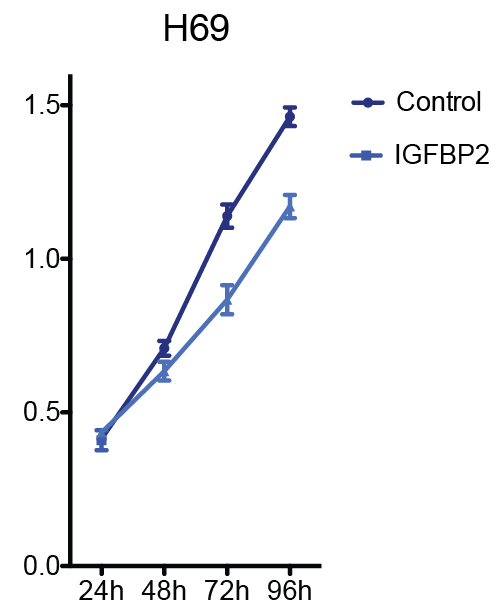Recombinant Mouse IGFBP-2 Protein, CF Summary
Product Specifications
Gln35-Gln305
Analysis
Product Datasheets
797-B2
Carrier Free
CF stands for Carrier Free (CF). We typically add Bovine Serum Albumin (BSA) as a carrier protein to our recombinant proteins. Adding a carrier protein enhances protein stability, increases shelf-life, and allows the recombinant protein to be stored at a more dilute concentration. The carrier free version does not contain BSA.
In general, we advise purchasing the recombinant protein with BSA for use in cell or tissue culture, or as an ELISA standard. In contrast, the carrier free protein is recommended for applications, in which the presence of BSA could interfere.
797-B2
| Formulation | Lyophilized from a 0.2 μm filtered solution in Acetonitrile and TFA. |
| Reconstitution | Reconstitute at 100 μg/mL in sterile PBS. |
| Shipping | The product is shipped at ambient temperature. Upon receipt, store it immediately at the temperature recommended below. |
| Stability & Storage: | Use a manual defrost freezer and avoid repeated freeze-thaw cycles.
|
Background: IGFBP-2
The superfamily of insulin-like growth factor (IGF) binding proteins include the six high-affinity IGF binding proteins (IGFBP) and at least four additional low-affinity binding proteins referred to as IGFBP related proteins (IGFBP-rP). All IGFBP superfamily members are cysteine-rich proteins with conserved cysteine residues, which are clustered in the amino- and carboxy-terminal thirds of the molecule. IGFBPs modulate the biological activities of IGF proteins. Some IGFBPs may also have intrinsic bioactivity that is independent of their ability to bind IGF proteins. Post-translational modifications of IGFBPs, including glycosylation, phosphorylation and proteolysis, have been shown to modify the affinities of the binding proteins to IGF.
Mouse IGFBP-2 cDNA encodes a 305 amino acid (aa) residue precursor protein with a putative 34 aa residue signal peptide that is processed to generate the 271 aa residue mature protein. Mouse and human IGFBP-2 share approximately 82% homology. IGFBP-2 contains an integrin receptor recognition sequence (RGD sequence) but lacks potential N-linked glycosylation sites. During development, IGFBP-2 is expressed in a number of tissues. The highest expression level is found in the central nervous system. In adults, high expression levels are also detected in the central nervous system and in a number of reproductive tissues. IGFBP-2 binds preferentially to IGF II, exhibiting a 2 - 10 fold higher affinity for IGF II than for IGF I.
- Jones, J.I. and D.R. Clemmons (1995) Endocrine Rev. 16:3.
- Kelley, K.M. et al. (1996) Int. J. Biochem. Cell Biol. 28:619.
- Schuller, A.G.P. et al. (1994) Mol. Cell. Endoc. 104:57.
- Landwehr, J. et al. (1993) Gene 124:281.
Citations for Recombinant Mouse IGFBP-2 Protein, CF
R&D Systems personnel manually curate a database that contains references using R&D Systems products. The data collected includes not only links to publications in PubMed, but also provides information about sample types, species, and experimental conditions.
8
Citations: Showing 1 - 8
Filter your results:
Filter by:
-
Redox-dependent Igfbp2 signaling controls Brca1 DNA damage response to govern neural stem cell fate
Authors: WS Shahin, SO Ebed, SR Tyler, B Miljkovic, SH Choi, Y Zhang, W Zhou, IA Evans, C Yeaman, JF Engelhardt
Nature Communications, 2023-01-27;14(1):444.
Species: Mouse
Sample Types: Recombinant Protein
Applications: Bioassay -
Aberrant astrocyte protein secretion contributes to altered neuronal development in multiple models of neurodevelopmental disorders
Authors: ALM Caldwell, L Sancho, J Deng, A Bosworth, A Miglietta, JK Diedrich, MN Shokhirev, NJ Allen
Nature Neuroscience, 2022-08-30;25(9):1163-1178.
Species: Mouse
Sample Types: Whole Cells
Applications: Bioassay -
Cyclic Pressure-Induced Cytokines from Gingival Fibroblasts Stimulate Osteoclast Activity: Clinical Implications for Alveolar Bone Loss in Denture Wearers
Authors: Y Akashi, A Nagasaki, H Okawa, T Matsumoto, T Kondo, H Yatani, I Nishimura, H Egusa
Journal of prosthodontic research, 2022-03-11;0(0):.
Species: Mouse
Sample Types: Whole Cells
Applications: Cell Culture -
Tbx3-dependent amplifying stem cell progeny drives interfollicular epidermal expansion during pregnancy and regeneration
Authors: R Ichijo, H Kobayashi, S Yoneda, Y Iizuka, H Kubo, S Matsumura, S Kitano, H Miyachi, T Honda, F Toyoshima
Nat Commun, 2017-09-11;8(1):508.
Species: Mouse
Sample Types: In Vivo
Applications: In Vivo -
Neural deletion of Tgfbr2 impairs angiogenesis through an altered secretome.
Authors: Hellbach N, Weise S, Vezzali R, Wahane S, Heidrich S, Roidl D, Pruszak J, Esser J, Vogel T
Hum Mol Genet, 2014-07-02;23(23):6177-90.
Species: Human
Sample Types: Whole Cells
Applications: Bioassay -
Evidence of a role for insulin-like growth factor binding protein (IGFBP)-3 in metabolic regulation.
Authors: Yamada PM, Mehta HH, Hwang D
Endocrinology, 2010-10-06;151(12):5741-50.
Applications: ELISA (Standard) -
Patched1 inhibits epidermal progenitor cell expansion and basal cell carcinoma formation by limiting Igfbp2 activity.
Authors: Villani RM, Adolphe C, Palmer J, Waters MJ, Wainwright BJ
Cancer Prev Res (Phila), 2010-09-21;3(10):1222-34.
Species: Mouse
Sample Types: Whole Tissue
Applications: Bioassay -
Dietary feeding of silibinin inhibits prostate tumor growth and progression in transgenic adenocarcinoma of the mouse prostate model.
Authors: Raina K, Blouin MJ, Singh RP, Majeed N, Deep G, Varghese L, Glode LM, Greenberg NM, Hwang D, Cohen P, Pollak MN, Agarwal R
Cancer Res., 2007-11-15;67(22):11083-91.
Applications: ELISA (Standard)
FAQs
No product specific FAQs exist for this product, however you may
View all Proteins and Enzyme FAQsReviews for Recombinant Mouse IGFBP-2 Protein, CF
Average Rating: 5 (Based on 1 Review)
Have you used Recombinant Mouse IGFBP-2 Protein, CF?
Submit a review and receive an Amazon gift card.
$25/€18/£15/$25CAN/¥75 Yuan/¥2500 Yen for a review with an image
$10/€7/£6/$10 CAD/¥70 Yuan/¥1110 Yen for a review without an image
Filter by:



